Background model for vehicle detection design
Abstract: In order to solve the problem that the vehicle detection method based on background difference is susceptible to traffic conditions, an adaptive background model based on interval distribution is first established, and then the improved background update algorithm is used to selectively update the established background model. The experimental results show that the algorithm has good background extraction and update effects in complex traffic environments such as traffic jams or temporary parking. Compared with the classical algorithm, the vehicle detection algorithm has improved in real-time and accuracy.
This article refers to the address: http://
With the development of intelligent transportation technology, traffic detection in intelligent transportation systems has become an important topic in the application of computer vision technology. Vehicle detection and tracking in sequence images play a key role in the field of intelligent transportation. Common methods for vehicle detection are based on inter-frame difference methods, optical flow methods, and background-based differential methods. The background-based difference method can solve the problems based on the inter-frame difference method and the optical flow method, and the calculation is simple, but the background is easily affected by the traffic environment and light intensity, and the ideal background is not easy to obtain. Therefore, the background model of adaptive environment change It plays a very important role in the accuracy of motion vehicle detection.
1 Algorithm Description
Algorithm is a series of clear instructions for solving problems. The algorithm represents a systematic way to describe the strategy mechanism for solving problems. That is to say, it is possible to obtain the required output in a limited time for a certain specification input. If an algorithm is flawed or not suitable for a problem, executing this algorithm will not solve the problem. Different algorithms may accomplish the same task with different time, space or efficiency. The pros and cons of an algorithm can be measured in terms of space complexity and time complexity.
Intelligent transportation system is a hot spot for research and development in the world of transportation in the world and in various countries. The method based on background difference is a common method for detecting moving objects from video streams, which is the focus of current research. Due to factors such as traffic conditions, weather and light intensity, it is not easy to obtain an ideal background, especially in the case of traffic jams, slow vehicle movements or temporary parking, etc., the background update rate is low.
Figure 1 is a flow chart of vehicle detection. Firstly, a fast adaptive background model based on interval distribution is established. Then, the improved background model based on ε-δ is used to selectively update the established background model, and combined with threshold segmentation and morphological operations to realize the extraction of moving vehicles. The experimental results show that the proposed algorithm has a good background extraction and update effect for complex traffic environments (traffic congestion, very large traffic flow, slow traffic flow, traffic jam or temporary parking). Compared with the classical algorithm, Both real-time and accuracy have improved.

2 adaptive background model
In order to solve the problem of vehicle detection accuracy, domestic and foreign scholars have done a lot of research on background modeling. Reference [4] uses the average of the pixels of the last N frames in the video image as the background model. This method requires multiple Gaussian mixture distributions for frequently changing pixels when multiple moving targets or moving targets move slowly. In order to reflect the changes in the background pixels. These methods require that there is no moving vehicle during the establishment of the background model and that the background model is established for a long time and cannot meet the needs of practical applications. This paper proposes a simple and effective background model and an updated method.
2.1 Establishment of the background model
In the video image sequence, the distribution of the pixel values ​​of each coordinate point can be counted, and the pixel value with a high frequency of occurrence is set as the pixel value of the corresponding point in the background model. However, this method is computationally intensive and has poor adaptability to gradual changes in light and background.
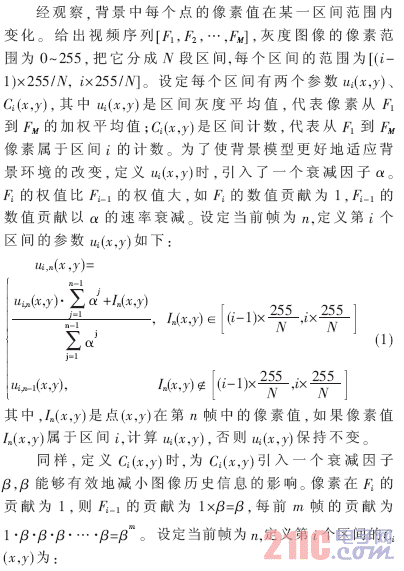

After defining ui(x,y) and Ci(x,y), the steps to create a background model are as follows:
(1) Determine which section the current pixel belongs to and set it to i.
(2) Calculate ui(x, y) and Ci(x, y).
(3) Classify the interval from small to large according to Ci(x, y).
(4) Set ui(x, y) of the section where Ci(x, y) is the largest as the pixel value of the corresponding point in the background model Mt.
(5) Repeat steps (1) to (4) for all pixels of each frame of the video stream.
2.2 Background model update
After the above several steps, a background model capable of adaptive light intensity variation is obtained. However, in the case of crowded vehicles, temporary parking, or slow vehicle movement, the background model is prone to errors, resulting in reduced vehicle detection accuracy. In order to obtain the ideal background model under complex traffic conditions, the paper proposes a criterion for updating the background model based on the traditional σ-δ background updating method.
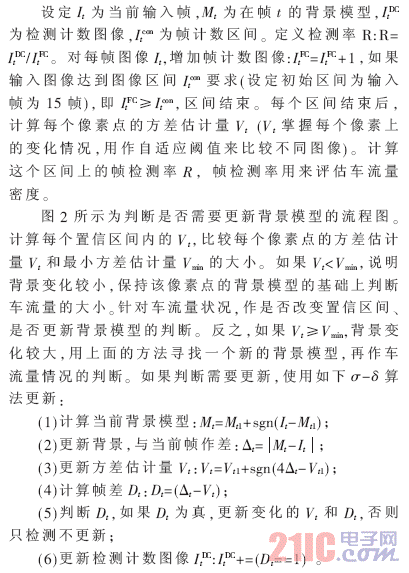
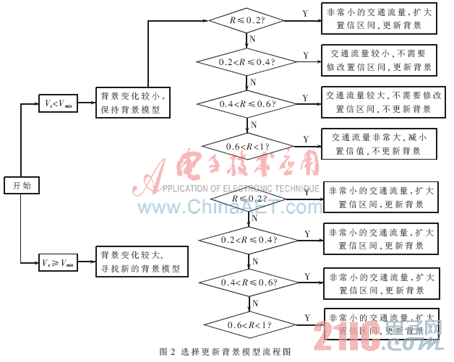
3 moving target extraction
After obtaining the reconstructed background, the moving target can be obtained from the difference between the current image and the background image. The background difference image is D(x, y) = I(x, y) - B(x, y). All sets of pixels in the image below this threshold will be defined as the background, and sets of pixels above this threshold are defined as moving targets. A normalized method is used, that is, a value of 0 that is lower than the threshold and a value of 1 that is higher than the threshold. Regardless of how the threshold is selected, the image after the single threshold segmentation can be defined as:

Threshold segmentation is a region-based image segmentation technique. The basic principle is to divide image pixel points into several categories by setting different feature thresholds. Commonly used features include: grayscale or color features directly from the original image; features derived from the original grayscale or color value transformation. Let the original image be f(x, y), find the feature value T according to a certain criterion f(x, y), and divide the image into two parts. The divided image is: if: b0=0 (black) , b1 = 1 (white), which is what we usually call image binarization.
In this paper, the Dajin method based on the maximum variance theory is selected as the processing algorithm for threshold segmentation in video vehicle detection. Taking the threshold to separate the object from the background actually divides all the pixels in the image into two groups, or belongs to the object pixel, or belongs to the background pixel. According to the theory in probability theory, if the variance of the two sets of data to be divided is maximized, the probability of misclassification of the two sets of data is the smallest.
After the threshold segmentation, it has been possible to successfully segment the moving vehicle. The binary image obtained by the Otsu method still has the problem of black pixel points inside the vehicle. In order to make the detected moving target complete and continuous, the binary image obtained by the background frame difference method is subjected to morphological expansion and corrosion. Experiments have shown that after three expansions and corrosion images, the hollow of the moving target can be basically filled.
4 Experimental results
This paper takes the vehicle automatic monitoring system in intelligent traffic as the application background, and proves the correctness of the proposed method through experiments. Experiment with a video of different scenes outdoors using a camera attached to a tripod. The experimental platform is simulated by PC Matlab7.0.
Figure 3 shows the extraction of the adaptive background model. Selecting the special temporary parking situation, the algorithm proposed in this paper can adaptively extract the background model. The algorithm proposed in this paper can obtain the ideal background model at frame 621, as shown in Figure 3. The method of extracting the background model using Gaussian distribution can obtain the ideal background model as shown in Figure 146. Therefore, the algorithm has improved the calculation speed compared with the traditional algorithm, and can detect the moving vehicle in real time.
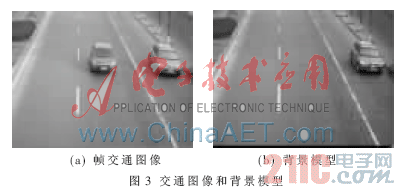
Figure 4 is a section of urban traffic video, Figure 5 is the temporary parking situation in urban traffic video, where the lower left corner is the original video, the lower right corner is the background model extracted by the algorithm, the upper left corner is the detected moving object, and the upper right corner is the calibration detection. Out of the sport vehicle. Figure 4 takes the 59th and 114th frames of the urban traffic video respectively. Figure 5 selects the 618th and 673th frames. It can be seen that in the busy urban traffic, the proposed algorithm can accurately detect the moving vehicles. .
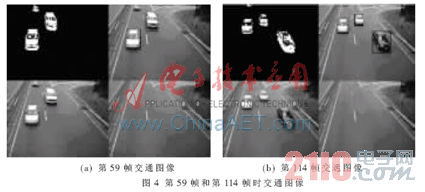
It can be seen from Fig. 4 that the moving vehicle can extract the ideal background model in real time in the urban traffic scene. The motion region is accurately obtained by the background difference method combined with threshold segmentation and morphological operations.
It can be seen from Fig. 5 that the background model can be accurately extracted when the temporary parking is performed. When the vehicle is merged into the traffic flow after a short stop, the vehicle slowly becomes blurred in the background, and the vehicle is extracted when the moving target is extracted. This algorithm can improve the calculation speed while ensuring the detection accuracy.

This paper implements vehicle detection based on the establishment and selective updating of the background model. In order to adapt to the rapidly changing traffic environment, this paper proposes an adaptive background model algorithm. After the adaptive background model is established, the moving target extraction is realized by using the difference between the gray image and the background model. The simulation experiment proves that the proposed algorithm establishes an environmental change background model such as adaptive light intensity at the pixel level, and estimates the traffic flow. It judges whether the background model is updated by estimating the traffic flow. The algorithm proposed in this paper has a good background extraction and update effect for complex traffic environment (traffic congestion, very large traffic flow, slow traffic flow, traffic jam or temporary parking, etc.), and can accurately extract the complete information of the moving vehicle in real time. .
Die-Casting Products,Led Die Casting,Pressure Die Casting,Aluminum Die Casting Led
Yangzhou Huadong Can Illuminations Mould Manufactory Co., Ltd. , https://www.light-reflectors.com